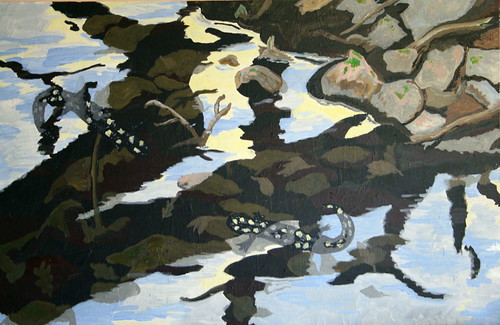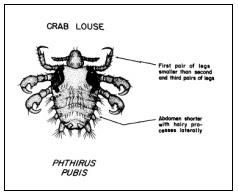Where poetry and biology meet. Enjoy and join in. This is the news in a different way.
Saturday, March 31, 2007
Causation in in Biology.
This distinction sometimes creates as Alex notes a divide among scientists in terms of their view points. For example when I was a graduate student there was a lot of interest in "r" vs "K" selection. Populations that are r selected invest heavily in reproduction and reproductive structures whereas K selected species or populations invest in structures that give them a competitive advantage. I went to a dissertation defense of a graduate student working on r and K selection in populations of a certain plant and the evidence seemed to support the student's hypothesis that in unstable environments with fewer competitors the plant should show attributes of an r selected species and in stable environments with more competitors the plant should show attributes of a K selected species.
To make a long story short, the poor graduate student was savaged by a plant physiologist in the audience who argued that the results were just due to physiological responses of the plant and had nothing to do with evolutionary explanations at all. There were weaknesses in the study and the student should have anticipated this sort of criticism. But the physiologist did not pick up on these weaknesses in terms of what the student needed to do to really test the hypothesis, instead ultimate causation was not even on his radar screen.
I have always been bothered by the use of the terms proximate vs ultimate causation explanations in biology and wrote a response to Alex's post. Basically my concern is with the use of ultimate. To me, ultimate implies teleology. Teleology implies directedness toward some sort of final goal, usually some sort of cosmological goal, or metaphysical goal, as opposed to intentional behavior on the part of an individual organism. To illustrate: my goal in writing this article is intentional but not teleological in the sense the word is usually used. I suppose were some one to say "water tends to seek it's own level" ,as students often do by the way, that is a sort of teleological statement, again seeming to imply intent.
So here is the scheme I proposed in my comments to Alex (cribbing heavily from my response on his blog, and correcting typos).
Teleological causality and explanations involve progression toward a final goal (teleos). This is metaphysics and outside the scope of science...at least science has found no empirical evidence that the universe's unfolding involves this sort of intentional movement toward a final goal.
Scientific causality and explanations are about the universe in terms of natural causation. These are "how questions" and it doesn't matter whether you are talking about cells or evolution. It their core all scientific explanations are explanations about mechanism-they are" how explanations."
Scientific causality and explanations in biology (I will ignore physics here) would include:
1. Proximal explanations-explanations about the immediate operation of organisms.
2. Evolutionary explanations-historical explanations about how the structure and adaptations of organisms and groups of organisms came to be in terms of modification with descent and the mechanisms by which modification with descent operates.
So in my scheme, ultimate is relegated to the sort of explanation that is outside the realm of empirical science because how do you know what the final goal is. What I am proposing is related to the problem of design since design implies intent. Evolutionists, myself included, often talk about the adaptations that organisms show as giving the illusion of design. After all, evolution is not intentional. It is not as Darwin realized, directed toward some sort of final goal. Evolution is not teleological, even though it has given rise to creatures that show intent and directedness toward immediate goals-teleonomy.
Whether or not teleology exists, or is an illusion is really what the intelligent design advocates are asking. The problem is that teleological explanations have not proven useful in terms of understanding the universe. Since they have never proven useful -water seeking it's own level is after a pretty useless explanation of fluid dynamics, the intelligent design advocates have a very difficult task ahead of them if they believe that teleological causality and explanations are needed to understanding the universe. If they have not been shown useful in biology whether we are talking cells or evolution, why should teleology even be on our radar screen as scientists?
Other links:
Setsuya Fujita (2001) Evolution of the Brain and the System of Value - Origin of Morality in
Bioethics and the Impact of Human Genome Research in the 21st Century pp 161-169
http://www.eubios.info/BHGP/BHGP161.htm
Technorati Tags:
Evolution
Teleology
Teleonomy
Intelligent design
Friday, March 30, 2007
Monkey Girl at JCCC

Last night at JCCC we had the privilege of hearing Ed Humes discuss his latest book, Monkey Girl, subtitled evolution, education and the battle for America's soul. Humes' book is at one level about the famous Dover Pennsylvania court case Kitzmiller et al v Dover Area School District (archived here)in which the Federal Judge struck down the Dover School Board's attempt to inject "intelligent design" into the science curriculum.
Humes noted as have many others, that there is a disconnect between what scientists believe about evolution and what the public believes. As most people know, and as Humes documents, more than half of Americans are skeptical of evolution-almost two thirds wanting some form of creationism taught along side evolution in science class. Humes attributes this disconnect to the existence of two separate "theories of evolution.
The first "theory" he called the "talk radio theory" or the "goo to you theory". This theory claims that:
- Evolutionists (called "Darwinists" in talk radio theory)believe that the origin of life is through random processes;
- Scientists are engaged in some sort of conspiracy to suppress or censor the truth;
- Evolution is in its last legs as a theory because of new scientific challenges;
- Evolution leads to Atheism and is connected to Hitler.
 Humes notes that Americans are quite right to reject these ideas. The problem of course is that these ideas are either wrong or a distortion of what modern evolutionists believe about what evolution means and how it operates.
Humes notes that Americans are quite right to reject these ideas. The problem of course is that these ideas are either wrong or a distortion of what modern evolutionists believe about what evolution means and how it operates.What scientists believe is the second theory-the REAL theory of evolution.
- Evolution is not about the origin of life but instead focuses on events once life has arisen. There is however an active research program looking at abiogenesis-the development of life from non living materials on the primordial Earth.
- Evolution is not strictly random since natural selection is not random. As an aside, it is true that we don't have any reason to postulate that natural selection is anything but unguided, but that is a different issue. After the talk I had a somewhat intense (but friendly) discussion with a fellow who failed to grasp the distinction between random and unguided.
- Evolution is not about denying God but is about common ancestry.
- As for Hitler, Hitler seems to have been influenced by a document called "Jews and their Lies" written in 1542 by Martin Luther.
Humes gave a good summary of the Dover case and notes that the ruling has not eased the culture wars-indeed the Judge in the case, a conservative Republican appointee, received death threats. Further Humes argues, and I see lots of hints of this at my school, that the battle ground is broadening to one about Church and State separation. He cited the example of a teacher who was teaching creationism in a science class. A student recorded this and when he complained, the STUDENT was vilified and the TEACHER argued that it was HIS religious freedom that was at risk. So the teaching of evolution becomes a violation of religious freedom! The school board's solution-ban taping in class.
Humes is very concerned about, what he views, a growing mistrust of science and he connects this mistrust to the decreasing number of American students going into science, resulting in a loss of America's competitive edge in various areas of science. Humes may be oversimplifying the causes of this loss, but this is something I really worry about because most of the scientists and science teachers, including myself, are products of the last great push for science education that took place in the 1960's in response to Sputnik.
He briefly touched on the Kansas Board of Education hearings where the scientists chose NOT to participate, and yet Kansas in sense provided a prelude to Dover according to Humes. In particular he discusses how Michael Behe got "skewered" by the Dover Lawyers in way that was not possible in Kansas.
Humes made a big push for increased support for science education at all levels including a commitment on the part of administrators to support their science staff in the the proper teaching of science including evolution.
 Oh on another note...almost forgot. Just before the Humes presentation, Jack Krebs was presented with the National Center for Science Education's Friend of Darwin award, something that is well deserved. Jack has been tireless in his advocacy of science, including but not limited to evolution. His work is a major reason for the recent political victory of moderates over the conservatives in the last Kansas Board of Eduction election. Congratulations Jack!
Oh on another note...almost forgot. Just before the Humes presentation, Jack Krebs was presented with the National Center for Science Education's Friend of Darwin award, something that is well deserved. Jack has been tireless in his advocacy of science, including but not limited to evolution. His work is a major reason for the recent political victory of moderates over the conservatives in the last Kansas Board of Eduction election. Congratulations Jack!My shots of the presentation did not come out so see Red State Rabble's coverage. This shot is a candid shot of Jack with Liz Craig and the last shot is Jack with Ed Humes.
 Thanks to Kansas Citizens for Science for arranging the Humes lectures at KU and at JCCC.
Thanks to Kansas Citizens for Science for arranging the Humes lectures at KU and at JCCC.Other Links:
Pat Hayes over at Red State Rabble has related coverage here ,here and here.
Quite a different reaction to Humes' talk at KU on Wednesday is from the Creationist blogger "For the kids" over at Reasonable Kansans
Technorati Tags:
Evolution
Dover
Ed Humes
Monkey Girl
Sunday, March 25, 2007
Vernal Pond
 Sometimes I see something that begs to be painted, such as this small feeder stream. I paint on occasion with acrylics and this had so many possibilities. I particularly love the flow of the reflected branches. I am also a sucker for the sort of very restrained color pallets this image would require. Also, I have not done a scene with lots of reflection so thought this would be fun.
Sometimes I see something that begs to be painted, such as this small feeder stream. I paint on occasion with acrylics and this had so many possibilities. I particularly love the flow of the reflected branches. I am also a sucker for the sort of very restrained color pallets this image would require. Also, I have not done a scene with lots of reflection so thought this would be fun. I normally paint on masonite but had this old canvas from a failed experiment so decided to try again. I have a small project in mind that masonite would be better suited.
I normally paint on masonite but had this old canvas from a failed experiment so decided to try again. I have a small project in mind that masonite would be better suited. Initial rough in with mars black. In retrospect, I might have been well off to do the sky reflection with a pale yellow wash.
Initial rough in with mars black. In retrospect, I might have been well off to do the sky reflection with a pale yellow wash. Adding some details of the stones and leaves underneath the reflections of the branches. Didn't want too much detail but to give the impression of things going on under the surface. At this point I started thinking of Three Worlds by M.C. Escher and what else I should put in the water.
Adding some details of the stones and leaves underneath the reflections of the branches. Didn't want too much detail but to give the impression of things going on under the surface. At this point I started thinking of Three Worlds by M.C. Escher and what else I should put in the water. Escher's carp wouldn't work but instead I began to think of the image as of a spring pond rather than a stream so put something I miss from spring ponds back in Massachusetts, namely spotted salamanders (Ambystoma maculatum). So how many to put? I decided on just two, though quite frankly thought about a real mating scene.
Escher's carp wouldn't work but instead I began to think of the image as of a spring pond rather than a stream so put something I miss from spring ponds back in Massachusetts, namely spotted salamanders (Ambystoma maculatum). So how many to put? I decided on just two, though quite frankly thought about a real mating scene.The salamander outlines are shown to the left...

Spotted salamanders have nice yellow spots and I wanted to feature them and brighten up the painting a bit without getting garish. You may notice I tend to work the whole painting with a particular set of colors as in the greys and blacks. The salamanders were done in ivory back and shades of grey made from ivory black. The yellow and lighter shades of yellow were made with cadmium yellow and titanium white. Note the yellow used in the reflections. This was cadmium yellow and titanium white diluted with gloss medium.
The final painting after initialing is shown below:

Click on the image for a larger view from my flickr photo stream.
It also may not be obvious from the image, but the white areas are just the underlying gesso. This is a larger painting than I normally attempt - 24" x 36". I will probably frame it either in a silver metal flat put together frame or use redwood moulding...cedar might be nice as well. Have miter box will travel!
Enjoy!
Technorati Tags:
painting
acrylic painting
salamander
Saturday, March 24, 2007
Update! Transgendered City Manager Fired...
One of the commissioners, Andy Guyette, according to another article was upset that Stanton allegedly went to some seminars at the National League of Cities as Susan. Guyette says he doesn't care that Stanton wants to be come a woman but that he "misrepresented himself on the City's dime" and has been "living a lie".
Guyette does have a point here, given the stereotypes many people have about transgendered individuals. But transgendered people who desire to transition, typically have to go through (or at least should go through) a standard protocol called the Harry Benjamin Standards of Care, which includes real life experience living as the desired gender, so in some sense what Stanton was doing made sense.
Another Headline in the St. Petersburg Times summed up the facts for many transgender people who decide to transition: "Change Sex? Lose Job."
Stanton may not have handled his situation in the best way, but my gut reaction to the charge that Stanton "was living a lie" is to ask could Stanton really have done things in a way to save his job? Somehow I think not. Not in Largo, and unfortunately not in many other places either, not yet.
Technorati Tags:
gender
transgender
Steve Stanton
Largo FL
Friday, March 23, 2007
Conscience and Love Reign Supreme...
Two good examples stand out from this week. First of all is this dialogue on NPR between Nathaniel Frank, senior researcher at the Michael D. Palm Center at University of California, and Richard Mouw, president of Fuller Theological Seminary in Pasadena, Calif. My son and I listened to this dialogue about homosexuality and we came away with the feeling that both men were trying hard to understand the other's position and view point. There was no accusations of homophobia, no scare tactics but good honest dialogue.
I am sure Richard Mouw would not agree with my next example, namely the recent pronouncement of the American Episcopal Church concerning the Dar es Salaam Communiqué of February 19, 2007 which attempts to provide "pastoral guidance to the American Church from the Anglican Community. I cannot do any better than to quote a key paragraph from the Episcopal Church pronouncement (My apologies for the length):
It is hard to predict history, but we may have in the Episcopal document something that 30 years from now will be recognized as a key document in the evolution of Christianity, even as the debate we are having as a civilization about diversity will seem hopelessly quaint."It is incumbent upon us as disciples to do our best to follow Jesus in the
increasing experience of the leading of the Holy Spirit. We fully understand
that others in the Communion believe the same, but we do not believe that Jesus
leads us to break our relationships. We proclaim the Gospel of what God has done
and is doing in Christ, of the dignity of every human being, and of justice,
compassion, and peace. We proclaim the Gospel that in Christ there is no Jew or
Greek, no male or female, no slave or free. We proclaim the Gospel that in
Christ all God's children, including women, are full and equal participants in
the life of Christ's Church. We proclaim the Gospel that in Christ all God's
children, including gay and lesbian persons, are full and equal participants in
the life of Christ's Church. We proclaim the Gospel that stands against any
violence, including violence done to women and children as well as those who are
persecuted because of their differences, often in the name of God. The Dar es
Salaam Communiqué is distressingly silent on this subject. And, contrary to the
way the Anglican Communion Network and the American Anglican Council have
represented us, we proclaim a Gospel that welcomes diversity of thought and
encourages free and open theological debate as a way of seeking God's truth. If
that means that others reject us and communion with us, as some have already
done, we must with great regret and sorrow accept their decision.It is incumbent
upon us as disciples to do our best to follow Jesus in the increasing experience
of the leading of the Holy Spirit. We fully understand that others in the
Communion believe the same, but we do not believe that Jesus leads us to break
our relationships. We proclaim the Gospel of what God has done and is doing in
Christ, of the dignity of every human being, and of justice, compassion, and
peace. We proclaim the Gospel that in Christ there is no Jew or Greek, no male
or female, no slave or free. We proclaim the Gospel that in Christ all God's
children, including women, are full and equal participants in the life of
Christ's Church. We proclaim the Gospel that in Christ all God's children,
including gay and lesbian persons, are full and equal participants in the life
of Christ's Church. We proclaim the Gospel that stands against any violence,
including violence done to women and children as well as those who are
persecuted because of their differences, often in the name of God. The Dar es
Salaam Communiqué is distressingly silent on this subject. And, contrary to the
way the Anglican Communion Network and the American Anglican Council have
represented us, we proclaim a Gospel that welcomes diversity of thought and
encourages free and open theological debate as a way of seeking God's truth. If
that means that others reject us and communion with us, as some have already
done, we must with great regret and sorrow accept their decision."
Other Links:
Episcopal Bishop's Statement
NPR Talk of the NAtion Interview with Mouw and Frank (audio-no transcript)
Richard Mouw's Blog
Nathaniel Frank article in LA Times
Nathaniel Frank on Don't ask Don't tell
Technorati Tags
homosexuality
Religion
ethics
GLBT
Thursday, March 22, 2007
Late night DNA fun in Second Life
 Simone's shown here with an attempt to make a single prim DNA strand through careful use of transparent textures. I think the concept works and I know what you are thinking...so this is what biologists do when it's too wet to go outside?
Simone's shown here with an attempt to make a single prim DNA strand through careful use of transparent textures. I think the concept works and I know what you are thinking...so this is what biologists do when it's too wet to go outside?Technorati Tags:
science
second life
genetics
education
The Obligatory Spring Goose

Actually this ties in to my posts about endemic invasive species since Canadian Geese are sometimes thought to a nuisance, especially around golf courses because they eat the grass and leave green droppings behind especially in Overland Park where I took this picture today. Let's see now..geese or golf courses, not much of a choice-give me the geese. They are the biggest bird the average person is likely to encounter. My only worry is that the geese might get an overdose of herbicides.
Geese are certainly opportunistic and have taken well to urban and suburban haunts. A similar urban bird phenomenon has been noted with crows, another traditionally rural species that has adapted to urban life, sometimes making pests of themselves. It's not clear if these shifts from rural to urban life are due to natural selection (Can you say evolution?) or due to learned behavior.
Technorati tags:
Kansas
Geese
JCCC
Urban Birds
A Deer Skull and Other Finds.

Along with this old foundation:

Here is cloesup showing faint chisel marks:

We were suprised by this herd of bison, or perhaps "beef-falo"

The Wakarusa:

There was lots of odd junk along the shore...
For instance
A lost idea:

and
a Kansas Puffball:

Wednesday, March 21, 2007
A Visit to the Gene Pool
 Since it is Spring Break, my Second Life Avatar, Simone decided to take a little trip to the Gene Pool (SLURL http://slurl.com/secondlife/Immaculate/234/219/22), a wonderful Second Life Site created by Dr. M.A. Clark at Texas Wesleyan. Now where else do you expect a genetics person to go on Spring Break? Caution! SLurls don't seem to work correctly at Internet Explorer 7.0. If you have Second Life installed, use secondlife/Immaculate/234/219/22 if the SLurl doesn't work.
Since it is Spring Break, my Second Life Avatar, Simone decided to take a little trip to the Gene Pool (SLURL http://slurl.com/secondlife/Immaculate/234/219/22), a wonderful Second Life Site created by Dr. M.A. Clark at Texas Wesleyan. Now where else do you expect a genetics person to go on Spring Break? Caution! SLurls don't seem to work correctly at Internet Explorer 7.0. If you have Second Life installed, use secondlife/Immaculate/234/219/22 if the SLurl doesn't work.The first thing that greeted me was a mock up of the Augustinian Abbey at Brno where Mendel did his work. Outside the Abbey is Mendel's Garden, showing some of the crosses Mendel conducted along with some other basic modes of classical inheritance.
 Inside the abbey is a rich environment including representations of artifacts from the abbey. Along the walls are slide shows showing some of Mendel's classic experiments, entertainingly named the Stations of the Cross.
Inside the abbey is a rich environment including representations of artifacts from the abbey. Along the walls are slide shows showing some of Mendel's classic experiments, entertainingly named the Stations of the Cross. Here is an example of the sort of detail found in the abbey, along with some of the information available to visitors by clicking on objects to get Second Life Note cards on various topics. In the image along with Simone are some of the Second Life navigational and camera aids.
Here is an example of the sort of detail found in the abbey, along with some of the information available to visitors by clicking on objects to get Second Life Note cards on various topics. In the image along with Simone are some of the Second Life navigational and camera aids. This is a shot showing incomplete dominance. A little explanation is in order here. As Dr. Clark explains these are obviously not peas but were a lot easier to represent!
This is a shot showing incomplete dominance. A little explanation is in order here. As Dr. Clark explains these are obviously not peas but were a lot easier to represent! There's more of course and outside I was intrigued by these bee hives, complete with friendly bees. One thing I did not know is that Mendel did breeding experiments with bees. Since bees are typically haplodiploid-the males are haploid the females diploid-Mendel must have found their genetics very confusing indeed!
There's more of course and outside I was intrigued by these bee hives, complete with friendly bees. One thing I did not know is that Mendel did breeding experiments with bees. Since bees are typically haplodiploid-the males are haploid the females diploid-Mendel must have found their genetics very confusing indeed! Also outside is the Genetics Complex. This deals with molecular genetics and also has a series of interactive experiments to give the student a feel for some of the classic experiments in modern genetics as well as a chance to use advanced bioinformatics tools such as BLAST.
Also outside is the Genetics Complex. This deals with molecular genetics and also has a series of interactive experiments to give the student a feel for some of the classic experiments in modern genetics as well as a chance to use advanced bioinformatics tools such as BLAST.Entering the tower, you are greeted by some DNA basics, such as Watson and Crick, the famous X ray diffraction photograph of Rosalind Franklin that was so critical to Watson and Crick's model building. To the right is the semi-conservative model of DNA replication.
 There are five levels to the Genetics complex which can be reached by either an elevator or a teleport system. Both are fun to do.
There are five levels to the Genetics complex which can be reached by either an elevator or a teleport system. Both are fun to do.Here are some of the highlights:
 A Drosophila lab where students can play with the tools used to study these flies.
A Drosophila lab where students can play with the tools used to study these flies. Here students can access BLAST, a well known tool for comparing DNA or proteins for phylogenetic analysis. In fact there is a whole floor devoted to phylogenetics.
Here students can access BLAST, a well known tool for comparing DNA or proteins for phylogenetic analysis. In fact there is a whole floor devoted to phylogenetics. A Gallery of chromosomes where students can access information about each chromosome in humans.
A Gallery of chromosomes where students can access information about each chromosome in humans. And here you can buy a chromosome shirt.
And here you can buy a chromosome shirt. This is the developer of the Gene Pool, Max Chatnoir talking with me about the Gene Pool. Max says the following about her site:
This is the developer of the Gene Pool, Max Chatnoir talking with me about the Gene Pool. Max says the following about her site:" I teach what is currently the only online science course offered by the
university -- a nonmajors course about the human genome. The challenge in
designing that course was in developing laboratory materials. The course is
now taught with a mix of "wet labs" that use materials from a lab kit
provided to students by the department and online bioinformatics
investigations that take advantage of the public genetics databases. I got
interested in the potential that Second Life offers to set up an online
laboratory environment (not necessarily for the human genome course), in
which students can generate and analyze data sets, and also get some
familiarity with various methods of genetic analysis. The site is evolving
as I learn to manipulate objects and write the scripts that activate them. "
 Back outside, there is a cell model that you can walk in and learn about cell structures.
Back outside, there is a cell model that you can walk in and learn about cell structures. And of course, the Gene Pool itself. Here's a view from under water in the gene pool. Eventually, according to Max, the gene pool will be devoted to population genetics.
And of course, the Gene Pool itself. Here's a view from under water in the gene pool. Eventually, according to Max, the gene pool will be devoted to population genetics. All the areas of the Gene Pool are connected by a fun ride which provides a running commentary about each area.
All the areas of the Gene Pool are connected by a fun ride which provides a running commentary about each area. Here's Simone back home with her chromosome shirt.
Here's Simone back home with her chromosome shirt.If you are thinking, as I am about using Second Life as an educational tool, I strongly recommend a visit to the Gene Pool. Max has skillfully blended scripts and links, textures and particles to create an engaging experience for any visitor, not just this genetics geek.
Other Second Life posts:
http://theforcethat.blogspot.com/2007/02/virtual-science-in-second-life.html
http://theforcethat.blogspot.com/2006/02/second-life.html
Technorati Tags:
science
second life
genetics
education
Tuesday, March 20, 2007
A Slow Day in Kansas...
Technorati tags:
Kansas
censorship
obscenity
Monday, March 19, 2007
Gay Babies Revisited
That said, the issue still remains the use of prenatal testing and also prenatal treatments. As we learn more and more about the role of genetics and fetal environment, people will do increased genetic screening and attempt hormonal interventions. First of all I hope that prospective parents get their science from other sources than PETA (indirectly through Tyler Gray) or from Reverend Mohler whose scientific perspective on the issue contains such gems as:
"Given the consequences of the Fall and the effects of human sin, we should not
be surprised that such a causation or link is found. After all, the human
genetic structure, along with every other aspect of creation, shows the
pernicious effects of the Fall and of God's judgment."
Sorry Reverend, your theology makes no sense scientifically, and suggests why one might want to apply a religious test for politicians and others-namely because you don't want social decisions made on the basis of clearly bad science (even if the source of that science is theology).
http://www.albertmohler.com/blog_read.php?id=891
Getting back to PZ Myers comments. He is absolutely right about the genetic complexities involved in genetic testing beyond the low fruit of relatively easily screened disorders. When you get into complex disorders or behavioral predispositions the issue gets really murky. Consider alcoholism for instance. In April's 2007 Scientific American, an article by John I. Nurnberger, Jr., and Laura Jean Bierut looks at the genetics of alcoholism and notes while alcoholism has a strong genetic component we are still a long ways from being able to pin point all the causes. Genes after all interact with each other and environment in complex ways that we don't really understand.
I wonder if the Mohler article or the Gray article would have attracted much attention if they had been about alcoholism rather than homosexuality? My guess is probably not and as empirical evidence offer up a quickie Google comparison. As of today the search "Nurnberger + alcoholism" had 35,100 hits and "Mohler+Gay+Baby", a more restricted search had 94,500 hits. Interesting? So why is this?
My take on this is that we get more and more queasy about any sort of genetic screening and intervention, the more we enter the sphere of complex behaviors-especially behaviors that involve some sort of group identity. Here is a little test you might try yourself in terms of fetal intervention. Which of the following statements(with Apologies to Reverend Mohlers) bothers you the most:
"If a prenatal test is then developed, and if a successful treatment to reverse
the tendency to be an alcoholic is ever developed, we would support its use as
we should unapologetically support the use of any appropriate
means to avoid temptation and the inevitable effects of sin"
"...If a prenatal test is then developed, and if a successful treatment to reverse the
sexual orientation to heterosexual is ever developed, we would support its use
as we should unapologetically support the use of any appropriate
means to avoid sexual temptation and the inevitable effects of sin."
"If a prenatal test is then developed, and if a successful treatment to reverse the
tendency to be a Baptist is ever developed, we would support its use as we
should unapologetically support the use of any appropriate
means to avoid temptation and the inevitable effects of sin"
"If a prenatal test is then developed, and if a successful treatment to reverse the
tendency to be an Atheist is ever developed, we would support its use as we
should unapologetically support the use of any appropriate
means to avoid temptation and the inevitable effects of sin"
Sound far fetched? Sure...but behavior and genetics do go together so it might not be so far outside the realm of possibility that attractions to certain types of religion or to even be religious might have some tenuous link to genetics, or maybe even prenatal developmental quirks.
We accept prenatal screening for clearly physical conditions, eg. PKU, Cystic fibrosis, Sickle cell anemia and yet dealing with behavior makes us really squeamish. It assails our notion that we have autonomy and control and it assails or sense of group identity. After all, religion is something that we take as part of our identification, as is sexual orientation, gender(read gender identity), ethnicity and race. We tend to want to label ourselves, put ourselves into groups. It gives us comfort and a sense of control and way of relating to others which seems pretty fundamental to humans.
But note what is interesting about these ways of identification. Some are clearly prenatally based with a relatively small over lay of choice afterwards-skin color and biological sex are good examples, gender identification and sexual orientation seem to to have prenatal and early post natal components-perhaps critical periods we just are not sure. This sort of thing may apply to alcoholism or depression and bipolar disorder as well. Religion is clearly a choice thing...but can we really discount the role of biology? So identity is not strictly about biological determinism but is on a continuum.
We don't want our identity threatened. For instance an article 1997 in the Advocate is titled: "Are We an Endangered Species", we referring to GLBT individuals. Of course we GLBT people are not a different species, the article raises the sector of using Eugenics to eliminate GLBT people:
"The dilemma posed by these conflicting value systems is exactly the issue that needs to be addressed, according to the Pro-Life Alliance of Gays and Lesbians. The group contends that if those who share Macklin’s viewpoint have their way, gay men and lesbians could be engineered and aborted out of existence. In a plea to other gays to support the group’s pro-life stance, its founder, Tom Sena, asked in a syndicated op-ed piece that ran in several publications in March, “What are gays and lesbians going to do now to prepare for a time when a woman’s ‘right to choose’ becomes a hunting license to exterminate our kind?” "
(emphasis mine).
You think that this sort of hyperbole is limited to GLBT people? Well consider those Christians who are concerned about the so called war on Christianity. Consider this article from the Washington Post which notes that some speakers compared Christians today to the Jews during Nazi Germany.
Or how about this site which warns:
"It is important to recognize that those who are working for the dissolution of our society have a spiritual agenda. They are not merely attempting to dismantle the historic cultural values of this nation and move us toward a homogenized world. They also want to destroy Christianity and Bible-based religion. It is a clear part of their agenda, and they have already moved a long way in that direction. "
Regardless of whether or not any of these claims are accurate, they do represent deeply held beliefs about threats to individual identity. This to me is where much of this concern about Mohler's article really stems from.
Ok so where I am I going here? First I agree with Myers and others that we really don't have enough information and knowledge to do what Mohler and other's seem to advocate. See for example:
http://theforcethat.blogspot.com/2006/06/natural-law-and-catholic-medical.html
for my basic position. It is ethically OK to do genetic screening in situations where genes have been clearly identified and fetal interventions where interventions have been clearly shown to be useful for otherwise medically harmful conditions. Being GLBT (or for that matter being Southern Baptist or having some genetically based predisposition to a certain religion) is NOT in the same league as PKU or CF. So talking about a prenatal cure for being gay makes no sense because how the genes, or for that matter the effects of prenatal environment, ultimately expressed depend on social factors and individual responsibility beyond the control of parents.
Mohler, in a sense is right, when he says we may not choose our sexual orientation but we are responsible for it. This responsibility is part of our need for identity and how we exercise this responsibility is contingent on the choices we make as autonomous individuals, intervening in those biological aspects of behavior, even were such possible eventually reduces our possible choices and reduces our scope of individual responsibility.
Mohler calls this whole issue a perfect storm because there are so many competing interests here. How could for instance liberals complain if a woman were to abort a fetus based on some test that showed that it might turn out gay? We might very well complain, quite frankly. I know I would just as I complain about prenatal sex selection. That said, in a pluralistic society some people are going to make ethical decisions we-liberal or conservative- are not going to like. That is the sort of trade off we make for having an open society composed of free individuals largely left alone to make their own ethical decisions. Who can complain about that?
Other links:
http://www.radaronline.com/from-the-magazine/2007/03/is_your_baby_gay_2.php
http://scienceblogs.com/pharyngula/2007/03/finally_an_issue_that_gets_fun.php
http://www.sciam.com/article.cfm?articleID=5C303E5F-E7F2-99DF-315ADC8A107AE976&ref=sciam&chanID=sa006
http://theforcethat.blogspot.com/2007/01/peta-and-gay-sheep-revisited.html
http://www2.ljworld.com/news/2007/mar/15/expand_newborn_screening/
http://www.eubios.info/PAPERS/PRENATAL.htm
Technorati Tags
homosexuality
Religion
Mohler
ethics
GLBT
Sunday, March 18, 2007
Timely letter in the Journal World...
"I believe in God, but I think it demeans him to attach his name to a concept that the apostle Paul called, on God’s behalf, the root of all evil, just as it demeans all good patriots to violate the concept of separation of church and state."
But then again maybe this attachment speaks volumes about what conservatism has become. What is it that Suze Orman says "First money, then things, then people?"...no wait!
Saturday, March 17, 2007
Senator Brownback's beliefs...
 Senator Brownback has come under increased scrutiny since his defense of General Pace's comments about the immorality of homosexuality as laid out in an open letter on his website. Of particular interest to all should be the concluding paragraph of the Senator's letter:
Senator Brownback has come under increased scrutiny since his defense of General Pace's comments about the immorality of homosexuality as laid out in an open letter on his website. Of particular interest to all should be the concluding paragraph of the Senator's letter:"The question is whether personal moral beliefs should disqualify an individual from positions of leadership in the U.S. military? We think not. General Pace's recent remarks do not deserve the criticism they have received. In fact, we applaud General Pace for maintaining a personal commitment to moral principles."
See also:http://www.cnn.com/2007/POLITICS/03/16/brownback.gays.ap/index.html
I wonder what the Senator would say if the General had said that "homophobia" was immoral?
Be that as it may the whole issue has obscured a deeper issue about Senator Brownback's beliefs and commitment to liberal Democracy as practiced in America. There is a very interesting article on Talk to Action about Brownback's beliefs, which if accurate, paint a picture of some one not fit to lead a modern secular society such as the United States. The article attempts to link the Senator with other conservative Catholics which according to another article in Media Transparency have targeted mainstream protestant denominations through an organization called the Institute on Religion and Democracy (IRD).
The Media Transparency article has this to say about the IRD:
"Michael Novak is a co-founder of IRD and has been a well-paid activist at the American Enterprise Institute (AEI) for more than two decades. Other power players at AEI include, Lynne Cheney, wife of Richard Cheney, and Newt Gingrich, former speaker of the House (AEI, 2006). Between 1985 and 2004, AEI received a whopping $42,342,101, mostly from right-wing funders; while Novak was given $1,527,397 in support from the Olin and Bradley foundations between 1985 and 2004 (Media Transparency, 2006c). With this funding Novak has worked to create moral and theological justification for unfettered corporate avarice, which according to some Catholic observers looks more like the teachings of Machiavelli than those of Jesus Christ (Zwick and Zwick, 1999)."
The IRD's home page says that the organization is committed to Church renewal and is ecumenical. James Tonkowich, the President of IRD says:
"the IRD has found it necessary to be a prophetic voice in the churches. We propose a turning back to the Gospel of Christ crucified. In the words of theologian and IRD board member Thomas Oden, we "are not presuming to create new doctrine but hold firmly to apostolic teaching in ways especially pertinent to current circumstances. The theology is orthodox, reliable, stable, beautiful, familiar, and glorious. By it the church has been blessed by God for two thousand years." And by it God blesses the church today and into the future."
Tonkowich, by the way is not Catholic, but Presbyterian and is associated with Breakpoint.org, which was founded by Chuck Colson. So it is probably a bit simplistic of Talk to Action and Media Transparency to focus on the role of conservative Catholics.
Clearly there is a growing alliance between conservative Catholics and some Evangelicals.
So what is this alliance based on? According to Talk to Action it is based on renewed interest in natural law theology, specifically Thomism, developed by St. Thomas Aquinas. The article claims that Thomism takes a hierarchical and paternalistic view of society and that:
" This paternalistic attitude of superiors wanting to tell the masses what their personal morality must be is part and parcel of much of today's Catholic Right. And just as royalty once justified their power by divine right, these nefarious actors seek to justify non-meritorious, non-commutative privilege via the very same distorted reasoning."
Personally, I don't know whether or not Brownback's beliefs are really of this type but take a look at what he says on his website:
"Religion, once an integral part of our society, is today being eradicated from nearly every aspect of public life. The First Amendment protects the freedom to practice the religion of one’s choice. That freedom is under attack by groups like the American Civil Liberties Union, who profit financially from lawsuits brought against cities and towns that display religious symbols. The ACLU and others have collected hundreds of thousands of dollars in legal fees from suits brought against local cities and towns. Now they are using those victories to threaten other local jurisdictions. I introduced the Public Expression of Religion Act last year to prevent groups like the ACLU from collecting attorneys’ fees in religious freedom cases. Our country was founded on the idea that its citizens should be free to express their religious beliefs without government interference. I will continue the fight to protect that freedom."See also http://brownback.senate.gov/pressapp/record.cfm?id=268117
If you analyze this closely what he seems to be saying is that governments (local municipalities etc) have the right to promote religion and that somehow this is the same thing as citizens being free to express their religious beliefs without government interference and government must step in to stop the evil ACLU from winning more victories against these local governments. Victories in the courts by the way but hey they must be victories in front of liberal activist judges.
As Brownback says:
"The role of a judge is to interpret the law, not to create it. Too many judges fail to remember the importance of this distinction. In recent years, activist judges around the country have been sidestepping state legislatures and the will of the voters, nullifying laws based not on the Constitution, but rather their own political agenda. The Senate must act to help prevent more activists from taking the bench. Government functions best when it is most accountable to the people. That is why I believe laws should be made by elected officials, and not by the federal judiciary. I will continue to support judges who adopt this philosophy."
Jeff Sharlet hit what's happening with the religious right and Brownback very well in a recent Rolling Stone article:
"Brownback is the beneficiary of a strategy known as co-belligerency -- a united front between conservative Catholics and evangelicals in the culture war. Pat Robertson has tapped the "outstanding senator from Kansas" as his man for president. David Barton, the Christian right's all-but-official presidential historian, calls Brownback "uncompromising" -- the highest praise in a movement that considers intransigence next to godliness. And James Dobson, the movement's strongest chieftain, can find no fault in Brownback. "He has fulfilled every expectation," Dobson says."
Brownback can talk the talk of non sectarianism as in this article from the Des Moines Register:
"Brownback, asked if he felt religious convictions and beliefs have become too important in today's political arena, was quick to counter such a concern. "No. I'd say look at the Founding Fathers, and did they have too much religion?" he said. "Abraham Lincoln? Martin Luther King? I don't support a theocracy. It's bad for government. It's bad for religion."
http://www.ustreas.gov/education/fact-sheets/currency/in-god-we-trust.shtml
But then he immediately backtracks:
""By the same token," Brownback said, "the country is built as a faith-based experiment country. 'In God We Trust' is our national motto. I don't think it requires you remove your faith from the public square, but rather accept that it's there, and it's to be shared with active involvement in a positive way. Faith is not a bad thing. It's something that should be celebrated and encouraged."
Somebody should remind the Senator that the original motto was "e pluribus unum" which is part of our National Seal and that in "God We Trust" was proposed after the Civil War. I also seem to have this idea that America was founded out of the sort of non sectarian faith of the enlightenment. Silly me, I should stop reading that stuff about Adams, Jefferson and Franklin. See this list of the religious beliefs of the founders of the United States. They were really quite a diverse lot religiously. If Brownback's critics are to believed, then Brownback harkens back to a sort of medieval pre-enlightenment philosophy at odds with the liberal philosophy espoused by the founders of this Country.
Technorati tags:
Kansas
Brownback
Friday, March 16, 2007
Interview with Steve Stanton
" The other thing up until then I was really able to segregate and compartmentalize a very bifurcated lifestyle to make sure that the world of Susan’s never clashed with the needs and the world of Steven. And for the first time in my life they did. And it scared me and it brought a sense of realization that I can’t continue to hide what I feel is an extremely dynamic part of my personality. Not only is it dishonest but it’s not going to continue to work."
Well said. By the way as noted by Jen over at Transcending Gender, Steve does want male pronouns used to refer to him for now. That makes sense since he presents as male currently. Tip of the antennae to Jen for the link to the Gender Advocacy interview.
Technorati Tags:
gender
transgender
Steve Stanton
Largo FL
Thursday, March 15, 2007
The Religion of Pigs
 One of the things I mention to my students from time to time is that we as human beings are really an assemblage of different species living with each other. An interesting article by Nicholas Wade on some of the important parasites that live in and one us drives this point home. As the article notes, we have a whole zoo of wee beasties living in or on us.
One of the things I mention to my students from time to time is that we as human beings are really an assemblage of different species living with each other. An interesting article by Nicholas Wade on some of the important parasites that live in and one us drives this point home. As the article notes, we have a whole zoo of wee beasties living in or on us.Image courtesy of ARS
 Certain bacterial parasites such as Streptococcus mutans which causes tooth decay and Helicobactor pylori, are not easily transmitted. This allows us to gain unexpected insight into the origin of these parasites. For instance, S. mutans is transmitted from mother to child and the distribution of different strains seems to parallel human migration patterns.
Certain bacterial parasites such as Streptococcus mutans which causes tooth decay and Helicobactor pylori, are not easily transmitted. This allows us to gain unexpected insight into the origin of these parasites. For instance, S. mutans is transmitted from mother to child and the distribution of different strains seems to parallel human migration patterns.Helicobactor pylori from http://en.wikipedia.org/wiki/Image:EMpylori.jpg
One particularly interesting conclusion about parasites turns our understanding of tapeworms on its head. The life cycle of some these parasites alternates between humans and pigs and it had long been thought that pigs were the original source of the parasite. But tapeworm infections appear to predate agriculture or domestication of pigs suggesting to some researchers that pigs were initially infected by humans. Indeed one of the tapeworms we passed to pigs may have come from humans infected eating dogs or each other. So Wade concludes by asking which animal would be considered unclean by pigs if pigs had religion.
 In case you're itching for more parasite stuff, Wade has an interesting summary of research into the evolution of lice at his blog, the Loom.
In case you're itching for more parasite stuff, Wade has an interesting summary of research into the evolution of lice at his blog, the Loom.Crab Louse image courtesy of NY Dept of Public health
Other links:
Out of Africa: The Origins of the Tapeworm
Lions and Tigers and oh no! Topeka in Second Life.
 While prowling around Second life today I stumbled upon the SL home of the Topeka Shawnee County Library. So if you have SL installed on your machine, use this SLURL to get yourself on over for a look see. There are pictures and Kansas Resources. But at least for the time being it is Fred Phelps free.
While prowling around Second life today I stumbled upon the SL home of the Topeka Shawnee County Library. So if you have SL installed on your machine, use this SLURL to get yourself on over for a look see. There are pictures and Kansas Resources. But at least for the time being it is Fred Phelps free.My Avatar, Simone is checking out a Kansas map that can be used to find cities in Kansas.
Oh! What is a SLURL? Literally a Second Life URL. Clicking on the link should take you to a Second Life map. If you have Second Life installed on your machine you will be teleported to the location. Cool? Yes!
http://slurl.com/secondlife/Cybrary%20City/18/161/25

This picture shows Ichabod, the Mascot of Washburn University. The panel gives access to many Kansas State resources. Note that in SL you can attach URL's to in world objects. There is a statement in the SL scripting language for doing this and the Shawnee County Library Site takes full advantage of this feature.
Technorati tags:
Kansas
Topeka
Shawnee County
education
Wednesday, March 14, 2007
In the Image of God?
"The biblical basis for establishing the dignity of all persons -- the fact that all humans are made in God's image -- reminds us that this means all persons, including those who may be marked by a predisposition toward homosexuality. For the sake of clarity, we must insist at all times that all persons -- whether identified as heterosexual, homosexual, lesbian, transsexual, transgendered, bisexual, or whatever -- are equally made in the image of God."If this is correct, what's to change? At least both he and I can agree that fetuses that might be identified as homosexual (not sure a fetus CAN be homosexual) should not be aborted...but I suspect our arrival at that agreement is from very different positions.
Technorati Tags
homosexuality
Religion
Mohler
Update on gender discrimination cases...
Meanwhile in Florida, transgender Susan(Steve) Stanton has decided to appeal her case to the Largo City Commission which earlier had voted to fire Stanton for disclosing that she is undergoing hormone replacement therapy and planning to have sexual reassignment surgery. The appeal was scheduled for March 23, though according to the report in the St Petersburg Times , her attorney has a conflict on that date but the commission refused to move the date to a time in April.
Other links:
His Second Self. A very good article about Stanton's history and struggles to come to grips with gender identity and the toll this has taken on her relationship with her family.
Technorati Tags:
gender
transgender
Julie Nemecek
Largo FL
Crawling with transitional forms...
Scientific American: From Jaw to Ear: Transition Fossil Reveals Ear Evolution in Action
Now hear this: early mammal fossil shows how sensitive ear bones evolved.
As Larry Martin said in response to creationist claims: "My drawers are crawling with transitional forms-" uh, meaning his fossil storage drawers of course.
Monday, March 12, 2007
Sean Carroll's Making of the Fittest
"Let's show students embryos, Hox clusters, stripes, spots and all the glory of making of animal form. The evolutionary concepts will follow naturally."
Carroll's fascinating new book, The Making of the Fittest(Norton) follows this strategy by taking a more general look at evolution focusing not only on the forms but also how they are connected to the evolutionary patterns revealed in the DNA. He starts out with a discussion of DNA in forensics, noting the contrast between the acceptance of DNA evidence in forensics with the skepticism in our society about evolution.
He considers it ironic that while people are almost 100% supportive about DNA evidence in the court room, more than 50% of citizens in the United States deny that evolution happens even though the patterns revealed by DNA studies speak more strongly than any other evidence about the reality of evolution. The goal of his new book is to make the case for the reality of evolution beyond any reasonable doubt. He clearly is taking on anti evolutionist and lawyer Phillip Johnson who in his writings during the 1990's tried to cast doubt on the reality of evolution, even though he does not once cite or mention Johnson.
Chapter one introduces us to a fascinating informal grouping of fish called "ice fish" which has a suite of adaptations to the extremely cold waters of the antarctic and he returns to these fish throughout the text to illustrate some of the patterns revealed in the DNA of many organisms.
Chapter two gives a brief and painless introduction to the mathematics of evolution emphasizing the power of even modest amounts of natural selection to affect evolutionary change in populations. He clearly explains the key concepts related to some classic examples of natural selection such as the Pepper moth and industrial melanism, so badly mangled by creationist Jonathan Wells in his Icons of Evolution.
One of the strongest sections is his discussion of fossil genes- for instance, the genes related to smell in which the number of pseudo genes or no longer functioning genes is highest in mammals with color vision. For instance mice have about 160 functional Vtr olfactory receptor genes while of the 200 such genes in our genome in our genome only 5 are functional, the rest are fossil genes. He hammers at this pattern with example after example so that by the time the punch line comes the reader is well prepared. The punch line of course is that fossil genes are evidence against two common erroneous notions: that evolution is progressive and that design or intent are involved in the development of life.
Later, he takes on another creationist canard, namely that evolution cannot give rise to novel biological forms and complexity and he makes his case convincingly using one of the favorite examples of creationists, namely the eye. He discusses the genetic underpinnings involved in the development of animal eyes, and in the rest of the chapter hammers creationist claims with example after example of complexity arising in the absence of an intelligent designer. He picks up one the themes of his research namely that animals share a common tool kit of genes involved in development and body planning.
Next he draws parallels between the tactics of anti evolutionists to Lysenkoism, and opposition of Chiropractors to vaccination noting in all three groups the same basic six strategies to under cut empirical science:
1. Doubt the science
2. Question the motives of scientists
3. Magnify disagreements among scientists and cite gadflies as authorities
4. Exaggerate potential harm
5. Appeal to personal freedom
6. Claim that acceptance (say of evolution or vaccination) repudiates key philosophy
I had to smile at these since this six fold strategy is exactly the one used by the previous Kansas Board of Education in its "hearings" on evolution the other year.
The book also gives many of the standard but important examples of the application of evolution to human problems and ends with a sobering look at how we are inadvertently causing the demise of fisheries due to poorly thought out and unintentional experiments in natural selection. The ending of the book is quite sobering noting that while we debate the existence of evolution our inadvertent evolutionary experiments are destroying the Earth's marine resources.
He leaves us with the question:
"Will we heed these facts and accept our responsibility...or will cod, tuna, marlin, blue whales, dugongs, icefish and more become as rare as palm trees in Wyoming".
The book is a great exercise in clear critical thinking. It is also highly accessible to the non biologist and I hope it has wide circulation.
Other Links:
Interview with Sean Carroll.
Sean Carroll's home page(http://www.molbio.wisc.edu/carroll/)
Technorati Tags:
Evolution
Biology
Genetics
